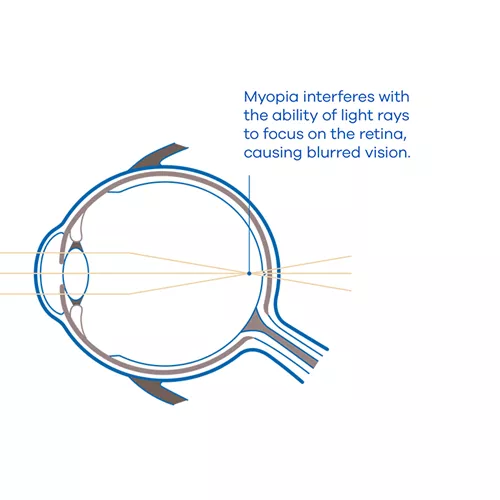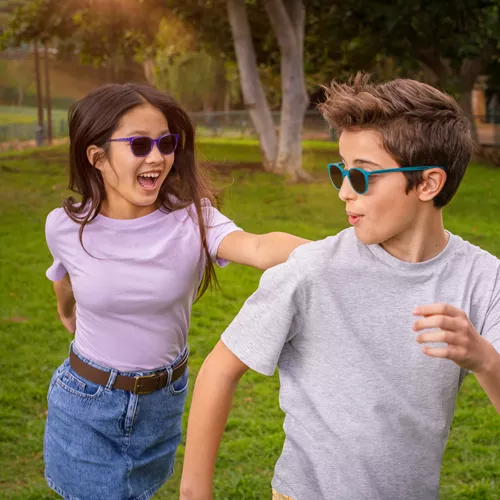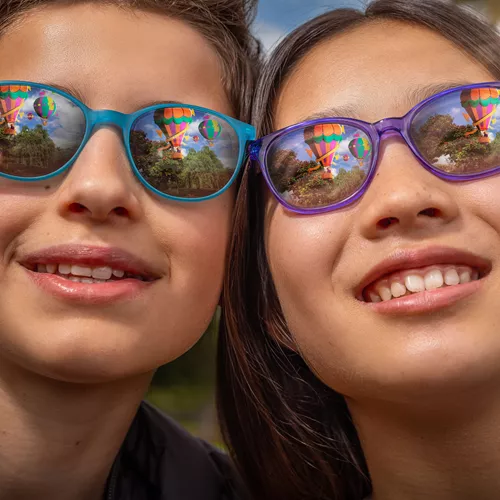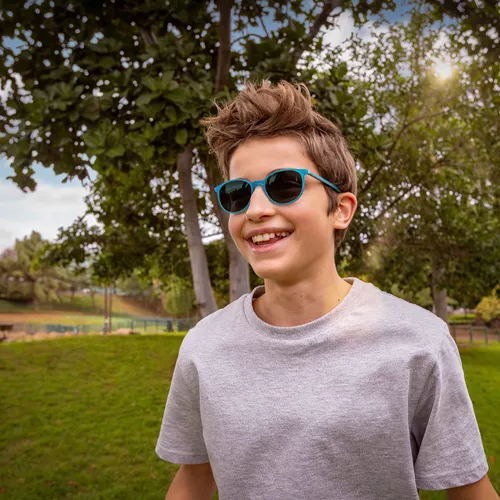Protect how your child sees the world, with MiYOSMART sun spectacle lenses
MiYOSMART SUN

What is Myopia?

What is myopia (near-sightedness) ?
Nothing is more important than the health and well-being of your child. Now and into the future, you want to see your child thrive. But you may have noticed your child struggling to see clearly at a distance, making it harder for them to concentrate at school and have a care-free experience at play. Your child may have myopia, also called near-sightedness.
If left untreated in children, myopia can lead to significant and lasting vision problems in the future.
When myopia increases by 1 diopter there is a 58% increased risk of future eye-related disease.1

Outdoor Time & Sun Protection

91% of Eye Care Professionals recommend spending at least 2 hours outdoors per day 2
Spending time outdoors is good for your child’s eyes, as it may slow down their myopia getting worse (myopia progression).3,4 In fact, it is the most common recommendation given by Eye Care Professionals to manage myopia,5 and may be the simplest and cheapest myopia treatment that you can encourage right away.

Your child’s eyes should be protected from intense sunlight when outdoors
Children are more susceptible to eye damage from UV light than adults, because:
- Most time spent outdoors happens before the age of 21.6
- Children’s eye structure differs to than of adults’, which means more damaging ultraviolet (UV) light reaches their eyes.7
Additionally, if your child uses atropine eyedrops for myopia treatment, their eyes are more likely to be sensitive to light.8-10 Therefore, it is especially important for your child to use effective and reliable sun spectacle lenses.

With MiYOSMART sun spectacle lenses, slowing down of myopia progression and protection from intense sunlight come together 11,12*
Traditional sunglasses may not be able to slow down your child’s myopia progression when they spend time outdoors.13,14 MiYOSMART sun spectacle lenses adopted D.I.M.S. Technology (Defocus Incorporated Multiple Segments), a unique lens technology that correct myopia and slows down its progression.11,12*
MiYOSMART sun spectacle lenses protect from intense sunlight, which provides eye comfort and encourages children to wear their spectacles outdoors.6, 15-17 They also offer protection from harmful UV rays,11† reducing the risk of long-term damage to the eye - so you can be sure your child’s eyes are well taken care of!
*Assuming self-tinting spectacle lenses are used at all times or in addition to MiYOSMART clear spectacles lenses, or polarized spectacle lenses are used in addition to MiYOSMART clear spectacle lenses.
†MiYOSMART polarized spectacle lenses and inactive MiYOSMART self-tinting spectacle lenses block 100% of harmful UV light, as per the ISO8980-3 (2022) standard.

MiYOSMART Sun

2-in-1 solution for any time and place
Your child may forget to change their spectacles every time they step outdoors. MiYOSMART Sun self-tinting (photochromic) spectacle lenses do it automatically for them. The self-tinting lenses rapidly adapt to the levels of sunlight, providing your child with as much protection as they need, wherever they are.11,12,18

Why Choose MiYOSMART Sun?
Features of MiYOSMART Sun:
- Clear (Category 0) lens indoors12
- Swift darkening to medium (Category 2) tinting when outdoors18
- Fades back to clear indoors in seconds18
- Stylish and subtle grey colour
Benefits of photochromic spectacle lenses:
- Decreased symptoms of light sensitivity (photophobia)16
- Reduced glare15-17
- Improved vision in intense sunlight and photostress recovery time15
Care Goes Beyond the Lens
Spend more time outdoors
Research shows that spending time outdoors at least 2 hours a day may reduce risk of myopia onset and its progression.2
Seek regular eye care
Get your child’s eyes checked to ensure myopia or other vision problems are detected and treated early. Be conscious of your child’s tendency to hide or downplay their vision problems.
Give eyes a break
Reduce your child’s eye strain by reminding them to take breaks from intensive screen time and short-sighted activities. Give the eyes a break every 20 minutes to look at a distance of 20 meters for 20 seconds or more.20
Want to know more about MiYOSMART?
Make an appointment with your local HOYA eye care professional
Disclaimer:
This webpage is intended for parents and caregivers of a child with myopia. Please always consult your Eye Care Professional for treatment decisions for your child’s myopia and instructions for using MiYOSMART spectacle lenses.
MiYOSMART has not been approved for myopia management in all countries, including the U.S., and is not currently available for sale in all countries, including the U.S.
References:
* Holden B.A., Fricke T.R., Wilson D.A., Jong M., Naidoo K.S., Sankaridurg P., Wong T.Y., Naduvilath T.J., Resniko_ S. Global Prevalence of Myopia and High Myopia and Temporal Trends from 2000 through 2050. American Academy of Ophthalmology. 05/2016, vol.123, no. 5, p.1036–1042. https://doi.org/10.1016/j.ophtha.2016.01.006
- 1. Mark A. Bullimore, Eric R. Ritchey, Sunil Shah, Nicolas Leveziel, Rupert R.A. Bourne, D. Ian Flitcroft, The Risks and Benefits of Myopia Control, Ophthalmology, 2021, ISSN 0161-6420, https://doi.org/10.1016/j.ophtha.2021.04.032.
- 2. HOYA data on file. Harris Interactive: HOYA Vision Care concept testing, MiYOSMART sun. 07/2022
- 3. Ho CL, Wu WF, Liou YM. Dose-Response Relationship of Outdoor Exposure and Myopia Indicators: A Systematic Review and Meta-Analysis of Various Research Methods. Int J Environ Res Public Health. 2019;16(14):2595.
- 4. Jonas JB, Ang M, Cho P, et al. IMI prevention of myopia and its progression. Invest Ophthalmol Vis Sci. 2021;62(5):6.
- 5. Myopia Survey Data. November 2022. Presented as part of WSPOS Symposium: Comprehensive Update on Myopia Management.19-20 November 2022. Available from: http://forum.wspos.org/symposium-part-1-comprehensive-update-on-myopia-management-2 (Last accessed: 20/02/2023)
- 6. Sunlight Exposure & Children’s Eyes Consensus Statement. 2016. Available at: https://www.wspos.org/wspos-sunlight-exposure-childrens-eyes-consensus-statement/ (Last accessed 11/10/2022)
- 7. Artigas JM, Felipe A, Navea A, Fandiño A, Artigas C. Spectral transmission of the human crystalline lens in adult and elderly persons: color and total transmission of visible light. Invest Ophthalmol Vis Sci. 2012;53(7):4076-4084.
- 8. Li FF, Yam JC. Low-Concentration Atropine Eye Drops for Myopia Progression. Asia Pac J Ophthalmol (Phila). 2019;8(5):360-365.
- 9. Gong Q, Janowski M, Luo M, et al. Efficacy and Adverse Effects of Atropine in Childhood Myopia: A Meta-analysis. JAMA Ophthalmol. 2017;135(6):624-630.
- 10. Wu PC, Chuang MN, Choi J, et al. Update in myopia and treatment strategy of atropine use in myopia control. Eye (Lond). 2019;33(1):3-13.
- 11. HOYA data on file. Transmission, traffic light recognition, and UV blocking test for MiYOSMART clear and MiYOSMART sun spectacle lenses. 02/2023. Tests were conducted at room temperature (23°C).
- 12. HOYA data on file. PSF test on MiYOSMART clear and sun spectacle lenses. 06/2022.
- 13. Jonas JB, Ang M, Cho P, et al. IMI prevention of myopia and its progression. Invest Ophthalmol Vis Sci. 2021;62(5):6.
- 14. Correction of Myopia Evaluation Trial 2 Study Group for the Pediatric Eye Disease Investigator Group. Progressive addition lenses versus single-vision lenses for slowing progression of myopia in children with high accommodative lag and near esophoria. Invest Ophthalmol Vis Sci. 2011;52:2749–57.
- 15. Lakkis C, Weidemann K. Evaluation of the performance of photochromic spectacle lenses in children and adolescents aged 10 to 15 years. Clin Exp Optom. 2006;89(4):246-252.
- 16. Renzi-Hammond LM, Hammond BR Jr. The effects of photochromic lenses on visual performance. Clin Exp Optom. 2016;99(6):568-574.
- 17. Wu PC, Kuo HK. Effect of photochromic spectacles on visual symptoms and contrast sensitivity of myopic schoolchildren treated with low dose concentration atropine. Invest Ophthalmol Vis Sci. 2016;57:2484.
- 18. HOYA data on file. Lens performance validation test for MiYOSMART photochromic lenses – activation and deactivation. 02/2023. Tests were conducted at room temperature (23°C).
- 19. Quintana MS, Langa A, del Moral-Martinez I, et al. Polarized Filters Enhance Contrast Sensitivity When Glare Is Produced On A Flat Surface Under Photopic Conditions. Invest Ophthalmol Vis Sci. 2006;47(13):1225.
- 20. Boyd K. Computers, Digital Devices and Eye Strain. 2020 [online]. American Academy of Ophthalmology. Available at: https://www.aao.org/eye-health/tips-prevention/computer-usage (Last accessed 08/03/2023)